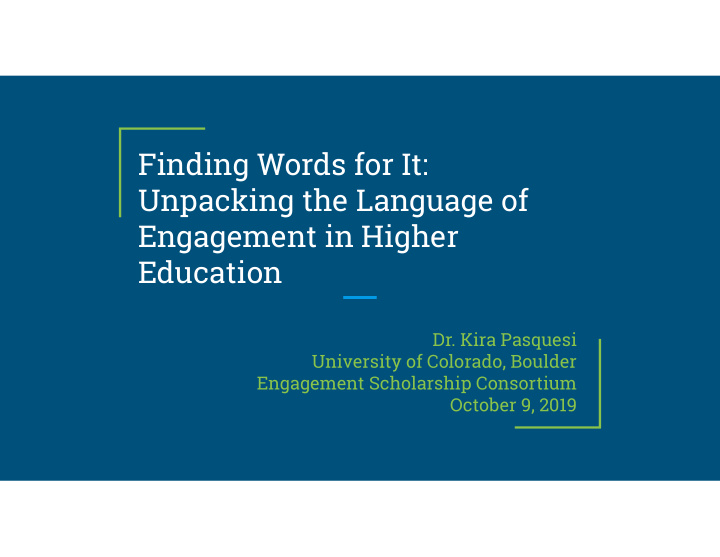



Finding Words for It: Unpacking the Language of Engagement in Higher Education Dr. Kira Pasquesi University of Colorado, Boulder Engagement Scholarship Consortium October 9, 2019
Session Agenda I. Opening poem II. Study purpose and research question III. Research methods IV. Key findings V. Implications for practice and research VI. Closing questions
Words for It I would ask them to hold you all night. I wish I could take language And daub and soothe and cool I wish I could take language Where fever blisters and burns, And fold it like cool, moist rags. Where fever turns yourself against you. I would lay words on your forehead. I wish I could take language I would wrap words on your wrists. And heal the words that were the wounds “There, there,” my words would say– You have no names for. Or something better. I would murmur, “Hush” and “Shh, shhh, it’s all right.” by Julia Cameron
What’s language got to do with it? ● Growing disconnect between diversity and inclusion efforts and community engagement initiatives on college campuses (Hurtado, 2007), along with “underside” of community engagement (e.g., Jones, Gilbride-Brown, & Gasiorski, 2005) ● Language is socially constructed and shaped by power relations within social institutions like colleges and universities (Fairclough, 2015) Language actively constructs representations of individuals, groups, ● organizations, and relationships (Wetherell, 2001) ● A critical examination of representations can uncover discursive strategies for maintaining inequities (van Dijk, 1993) Scant research exists on language use in community engagement ●
Study Overview The purpose of the study was to describe how colleges and universities use language to represent diversity and inclusion in community engagement. Primary RQ: In what ways do colleges and universities use language to represent diversity and inclusion in community engagement?
Research Design Qualitative methodology ● Critical discourse analysis ● (Fairclough, 2015) using a multiple case study approach (Yin, 2009) ● Critical research paradigm (Hurtado, 2015; Rossman & Rallis, 2003) Fairclough, 2013
University Cases City Heights Mountain View Small Town University University University Private, master’s Public, doctoral Small, public liberal granting university granting university arts university 5,000+ students 12,000+ students Fewer than 2,000 students Growing midsize city Small city in the west in the Midwest Remote town in the Midwest
Research Sub-Questions Data Sources How does language in application responses for ● First-time documentation framework (16 the Community Engagement Classification pages) represent diversity and inclusion? ● Written application responses for the 2015 classification process (3 documents, 164 pages) ● Focus on diversity and inclusion question (“Is community engagement connected with diversity and inclusion work (for students and faculty) on your campus?”) How does language in application responses for Transcribed audio recording from individual the Community Engagement Classification interviews (6 interviews, 79 pages) represent diversity and inclusion? How does language on community engagement Web page screenshots (69 pages from 36 office web pages represent diversity and hyperlinks) inclusion?
Descriptive Findings Description of texts for each university case study Review of text properties across cases Not about people or places - language use
Sample Descriptive Findings ● Intertextuality with university documents University as “do-er” of action and community as recipient of action ● Diversity or diverse as replacements for named social identities ● ● Diversity as something/someone to be managed or counted ● Supplemental nature of diversity and inclusion ● Presuppositions in “the” community “Us/them” distinctions in pronoun use ● Diverse as a descriptor of groups or place ● ● Community as a seamless unit
Interpretative Findings Representations of Representations of Diversity Inclusion ● Diversity as a seamless ● Inclusion as correction “other” ● Inclusion as honoring ● Diversity as a proxy ● Inclusion as a skillset ● Diversity as a commodity
Diversity as a Seamless “Other” ● Labels of groups as diverse (diverse community, diverse population, diverse students) Presumes familiarity with where diversity resides and reference group of ● interest (Latino community) ● Seamless unit of non-white bodies (pronoun “them”) as a recurring other in university community engagement (otherness outside the institution or “other” within institution) Make invisible inequalities, discount divisions, and erase power differentials ● for the sake of seamlessness ● Signaling who and what is diverse, but also who and what is not
Inclusion as Honoring ● Universities or university stakeholders being honored by a relationship with a “diverse” entity (NAACP) or as conveying honor upon one (Dr. King) “Food and fun” nature of an empowerment script that can simultaneously ● demonstrate connection yet foster distance ● Diverse bodies welcomed into spaces as temporary residents or guests with unwritten conditions for admission Terms or conditions can include a willingness to be repaired, celebrated, or ● empowered for the sake of university promotion or student learning
Explanatory Findings Discourse Types Ideologies Managerial Neoliberalism Promotional White supremacy Specialist Oppositional
Study Implications For practice: For research: Opportunities for language-based Research partnership with the ● ● interventions to promote critical Carnegie Foundation reflection-in-action ● Additional sources of language ● Teaching and practicing critical from community engagement language skills (i.e., naming) practice ● Fostering environmental ● Socialization processes of conditions for unlearning language language use in community use and disrupting shame engagement actor narratives
Wonderings (and wanderings) ● How can we tell stories of justice, solidarity, and shared futures through our language use? What does it look like and feel like to lean into the emotional discomfort of ● examining language-in-use? ● How can we engage tensions in the language of diversity and inclusion to advance new ways of speaking to and about one another? How can language use facilitate agency and healing? ● What do we want the vocabulary of engagement to communicate during this ● moment, and to whom?
”To exist, humanly, is to name the world, to change it. Once named, the world in its turn reappears to the namers as a problem and requires of them a new naming . Human beings are not built in silence, but in word, in work, in action-reflection.” Paulo Freire Pedagogy of the Oppressed
Recommend
More recommend